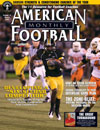Article CategoriesAFM Magazine
|
Historical Perspective of the Single Wing Offenseby: John BeckerFootball Coach © More from this issue Historical Perspective of the Single Wing Offense By John Becker, Football Coach Often times we think that a new offensive formation or scheme is innovative and has never been seen before.† As a young man in the 1970ís, my father would often recount stories of his 1948 undefeated and untied (untied was very important) mythical state championship team in Marshalltown, Iowa.† He would tell my brother and me about this strange offense where the center had to be especially skilled as a long snapper because he had to lead the running back to the play-side when snapping the ball directly to him.†† My father played weak-side guard in an unbalanced line.† I always thought this offensive scheme to be outdated and would never work with modern athletes.† However, the use of the single wing offense in recent years has chan....The full article can only be seen by subscribers.
|
|
|||||||
| HOME |
MAGAZINE |
SUBSCRIBE | ONLINE COLUMNISTS | COACHING VIDEOS |
Copyright 2025, AmericanFootballMonthly.com
All Rights Reserved





